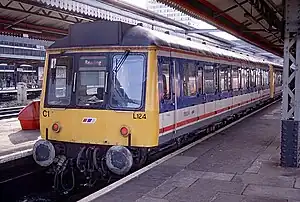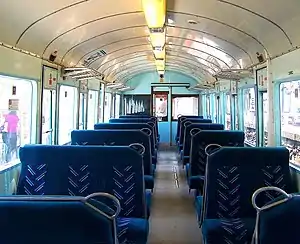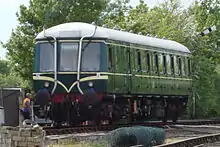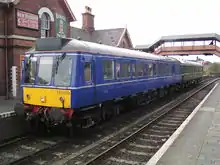| British Rail Class 121 Bubble Car | |
|---|---|
 A Class 121 at Reading in 1992 | |
 Interior of 121032 | |
| In service | 1960–present |
| Manufacturer | Pressed Steel Company[1] |
| Order no. |
|
| Family name | First generation |
| Replaced | Steam locomotives and carriages GWR railcars |
| Constructed | 1960–1961 |
| Entered service | 1960 |
| Scrapped | 1978–2011 |
| Number built |
|
| Number preserved |
|
| Number scrapped |
|
| Formation |
|
| Diagram | |
| Fleet numbers |
|
| Capacity |
|
| Operators | British Railways Network SouthEast Regional Railways Silverlink Railtrack Network Rail Arriva Trains Wales Chiltern Railways |
| Depots | |
| Lines served | |
| Specifications | |
| Car body construction | Steel[1] |
| Car length | 64 ft 6 in (19,660 mm) (over body)[4] |
| Width | 9 ft 0 in (2,740 mm) (over body)[4] |
| Height | 12 ft 4+1⁄2 in (3,772 mm)[4] |
| Doors | Slam[1] |
| Articulated sections | Single car (2) |
| Wheelbase |
|
| Maximum speed | 70 mph (110 km/h)[4] |
| Weight |
|
| Prime mover(s) | |
| Engine type | 11.1-litre naturally aspirated Diesel |
| Cylinder count | 6 (horizontal) per engine [4] |
| Power output | 300 hp (220 kW) (DMBS)[1] |
| Transmission | Mechanical (DMBS)[4] |
| HVAC | Oil burning air heater[4] |
| Bogies |
|
| Braking system(s) | Vacuum[4] |
| Safety system(s) | AWS (DMBS)[4] |
| Coupling system | Screw[11] |
| Multiple working | ■ Blue Square[1] |
| Headlight type | Fluorescent and tungsten[4] |
| Track gauge | 4 ft 8+1⁄2 in (1,435 mm) |
The British Rail Class 121 is a single-car double-ended diesel multiple unit. 16 driving motor vehicles were built from 1960, numbered 55020–55035. These were supplemented by ten single-ended trailer vehicles, numbered 56280–56289 (later renumbered 54280–54289). They have a top speed of 70 mph, with slam-doors, and vacuum brakes. The driving motor vehicles were nicknamed "Bubble Cars" by some enthusiasts (a nickname endorsed and made official by final passenger service operator Chiltern Railways).[12]
The Class 121 is Britain's longest serving DMU, operating in passenger service for 57 years until 2017.
British Railways service

The Class 121 vehicles were introduced in 1960 for use on the Western Region of British Rail. They were used on various lightly used branch lines in Cornwall including the Looe branch, the branch lines off the main line in the Thames Valley including the Greenford Branch Line, the Bridport branch line (closed 1975), and the Severn Beach line in Bristol. In 1978 all of the units were still allocated to Western Region depots.[13]
Unlike the earlier (but similar) Class 122, which had a small destination indicator in the roof dome, Class 121 had a four-character headcode box in the roof dome, with the destination indicator inside the top of the centre cab window.
Current operations
Upon privatisation of Britain's railways, the Class 121 fleet was only operated by one passenger company, namely Silverlink, with several more units in departmental duties with Railtrack. Since Chiltern Railways retired its final two units in May 2017, there have been no examples left in revenue-making service.
However, Network Rail operates one Class 121 for various departmental roles. This has been reclassified as a Class 960 departmental unit. Duties include route learning, video surveying of track and sandite application. In addition, the unit has been specially repainted in old BR blue livery. The unit is based at Aylesbury and was jointly used by Chiltern Railways for route learning.
Past operations
Silverlink
Silverlink inherited a small fleet of four "Bubble Cars". They were mainly used on the Marston Vale Line from Bletchley to Bedford, as well as non-electrified lines in North London, such as the Gospel Oak to Barking line. The units replaced the previous fleet of Class 108 and Class 115 units, and were supplemented with a fleet of Class 117 units cascaded from Thames Valley services.
The four units, nos. 55023/27/29/31, were based at Bletchley depot, where staff repainted set L123 (55023) into its original British Railways green livery. The others remained in obsolete Network SouthEast livery. In 1996, set L123 was withdrawn from traffic, and the other three were hired to Great Eastern for use on the Sudbury branch. These returned to Bletchley in 1997/98. Two of the units (121027 and 121029) were repainted into Silverlink's purple and green livery, and the third (121031) was repainted into Network SouthEast livery. The three units also received names from withdrawn Class 117 units.
- 121027 - Bletchley TMD
- 121029 - Marston Vale
- 121031 - Leslie Crabbe
The units were replaced on Silverlink duties in 2001 by Class 150 Sprinter units which had been cascaded from Central Trains. The units have all since been transferred to departmental duties.
Arriva Trains Wales
In 2006, 121032 was purchased by Arriva Trains Wales for use on the Cardiff Bay Shuttle. The unit has been repainted into Arriva colours and was hauled to Wales in June 2006 to enter service in July. The unit finally entered service on 16 August 2006 but was withdrawn 3 days later due to a major problem with the engine. The unit re-entered service on the Cardiff Bay line on 14 September 2006. In March 2013, following further extensive periods out of traffic, 121032 was finally withdrawn from service, due to a terminal engine fault. It was subsequently transferred to sister company Chiltern Railways and moved to Aylesbury at the beginning of 2014 and was later sold into preservation at the Wensleydale Railway, moving north at the beginning of May 2015.
Chiltern Railways

In 2003, Chiltern Railways reintroduced "Heritage" diesel multiple units on its Aylesbury to Princes Risborough shuttle service. For this purpose, unit 121020 was purchased from Network Rail, and heavily refurbished to allow it to operate passenger services. It was repainted into Chiltern Railways blue livery. The introduction of this unit allowed the release of a Class 165 "Network Turbo" unit. This unit has been fitted with secondary (magnetic) door locking and other safety features, and thus was exempt from 30 November 2005 deadline for the withdrawal of all Mark 1 vehicles. Electronic destination indicators and internal passenger information systems were recovered from "Network Turbo" 165 032 at refurbishment and fitted to this unit. The external exhaust pipes were rerouted through the brake van area.
In May 2011, a second "Bubble Car" was reintroduced to regular service. Unit 121034, previously based at Tyseley Loco Works, was (less extensively) refurbished for use by the Birmingham Railway Museum. It is painted in BR Green livery and was also used on Aylesbury to Princes Risborough services, when required.[14]
Both units were additionally used on shuttles, as required, between Aylesbury and Quainton Road stations, on the occasion of events at the Buckinghamshire Railway Centre.
In March 2013, Chiltern Railways acquired 121032 from Arriva Trains Wales. It sold the unit for preservation in 2015.
Chiltern's two final units were withdrawn from service on 19 May 2017, due to difficulties in obtaining spare parts given the age of the units, which were more than 50 years old. They are to be sold.[15]
Fleet details
Active units
Remarkably, considering the age of the fleet, the oldest unit (55020) was also the final unit withdrawn alongside 55034, which remained in daily service until 2017, whilst the youngest vehicle (55035) was the first to be dismantled. As of July 2014, 55021 (960021) and 55030 (960013) have also been scrapped.
Preservation
Class 121s have proved popular for preservation on heritage railways.
| Vehicle no. | Unit no. | Vehicle type | Location | Notes | |
|---|---|---|---|---|---|
| Original | Departmental | ||||
| 56287 | – | L211 | DTS | Epping Ongar Railway[16] | |
| 56289 | – | L263 | DTS | East Lancashire Railway | |
| 55020 | 977722 | L120 | DMBS | Bodmin and Wenford Railway[17] | Departmental unit 960002 (1992–2002) then returned to passenger use until 2017[18] |
| 55022 | 977873 | L122 | DMBS | Southall Railway Centre | Departmental unit 960014[19] |
| 55023 | – | L123 | DMBS | Chinnor and Princes Risborough Railway | |
| 55024 | 977858 | L124 | DMBS | Returned to traffic 30 March 2019 | |
| 55025 | 977859 | L125 | DMBS | MoD Long Marston | Stored for use on the Bristol and North Somerset Railway[20] |
| 55026 | 977824 | T005 | DMBS | – | Preserved at Swansea Vale Railway but scrapped in 2009[21] |
| 55027 | 977975 | P127 | DMBS | Ecclesbourne Valley Railway | Previously Severn Tunnel emergency train 960302 |
| 55028 | 977860 | L128 | DMBS | Swanage Railway | |
| 55029 | 977968 | L129 | DMBS | Rushden, Higham and Wellingborough Railway | Damaged by fire in May 2015.[22] |
| 55031 | 977976 | T002 | DMBS | Ecclesbourne Valley Railway | Previously Severn Tunnel emergency train 960303 |
| 55032 | T003 | DMBS | Wensleydale Railway | ||
| 55033 | 977826 | T004 | DMBS | Colne Valley Railway | Only bubble car to have carried Midline livery, when operating in the West Midlands PTE area. |
| 55034 | 977828 | T005 | DMBS | Locomotive Services Limited; Crewe[23] | Latterly operated by Chiltern Railways as 121034 |
Order details
| Lot No. | Type | Diagram | Qty | Fleet numbers | Notes |
|---|---|---|---|---|---|
| 30518 | Driving Motor Brake Second (DMBS) | 512 | 16 | 55020–55035 | |
| 30519 | Driving Trailer Second (DTS) | 513 | 10 | 56280–56289 | |
Model railways
In 2006 Hornby Railways launched its first version of the BR Class 121 in OO gauge.[24] Since 2017 Hornby have produced a basic representation of the prototype as part of their Railroad range in BR Class 121 in BR Green.
References
- 1 2 3 4 5 6 7 "Class 121, 149". The Railway Centre. Archived from the original on 9 March 2005.
{{cite web}}: CS1 maint: unfit URL (link) - ↑ Marsden 1983, p. 88
- 1 2 Fox 1987, pp. 30–31
- 1 2 3 4 5 6 7 8 9 10 11 12 13 14 15 Vehicle Diagram Book No. 220 for Diesel Multiple Unit Trains (Railcars) (PDF). Derby: British Railways Board. 1982. DQ221, DS201. Archived from the original (PDF) on 21 January 2015. Retrieved 19 February 2016 – via Barrowmore MRG.
- 1 2 Fox & Hughes 1994, p. 12
- 1 2 Hemming 1978, p. 12.
- ↑ Heginbotham, Stephen (2010). Cornwall's Railways Remembered. Halsgrove. pp. 51–52. ISBN 978-0-85704-005-3.
- ↑ "ROLLING STOCK". The North Cornwall Railway. Archived from the original on 11 April 2021. Retrieved 11 April 2021.
- ↑ Vaughan 1983, p. 106.
- ↑ Marsden 2011, p. 98
- ↑ "Mechanical And Electrical Coupling Index". Rail Safety and Standards Board. Archived from the original on 21 December 2013. Retrieved 20 December 2010.
- ↑ "Retirement of the Class 121 "Bubble Car" – Last Day of Service on Chiltern Railways". Chiltern Railways. 9 May 2017. Archived from the original on 14 April 2018. Retrieved 20 May 2017.
- ↑ Bowles, LJ; Mallaband, P (1978). Coaching stock of British Railways. RCTS. p. 50. ISBN 0-901115-44-4.
- ↑ Miller, Mark (18 May 2011). "Chiltern's latest trains are 50 years apart". RAIL. No. 670. p. 11.
- ↑ "The end is nigh for Chiltern's 'Bubble cars'". Rail Magazine. 10 April 2017. Archived from the original on 20 April 2017. Retrieved 4 May 2017.
- ↑ "BR 56287 Class 121 DMU". The Railway Heritage Register Carriage Survey Project. Retrieved 17 February 2023.
- ↑ "55020". Railcar.co.uk. Archived from the original on 14 April 2018. Retrieved 13 April 2018.
- ↑ "55020 Details". Railcar.co.uk. Archived from the original on 14 April 2018. Retrieved 13 April 2018.
- ↑ "55022 Details". Railcar.co.uk. Archived from the original on 14 April 2018. Retrieved 13 April 2018.
- ↑ "55025". Archived from the original on 30 October 2016. Retrieved 29 October 2016.
- ↑ "55026". Railcar.co.uk. Archived from the original on 14 May 2021. Retrieved 13 April 2018.
- ↑ "BR 55029 Class 121 Single Unit DMU: Driving Motor Brake 2nd built 1960". Retrieved 10 October 2019.
- ↑ "55034". Archived from the original on 7 July 2018. Retrieved 20 January 2021.
- ↑ "Hornby BR Class 121". Hornby Railways Collector Guide. Archived from the original on 11 January 2020. Retrieved 2 February 2020.
Sources
- Fox, Peter (1987). Multiple Unit Pocket Book. British Railways Pocket Book No.2 (Summer/Autumn 1987 ed.). Platform 5 Publishing Ltd. ISBN 0906579740. OCLC 613347580.
- Fox, Peter; Hughes, Barry (1994). DMUs & Channel Tunnel Stock. British Railways Pocket Book No.3 (7th ed.). Platform 5. ISBN 9781872524597.
- Hemming, R (August 1978). British Rail DMU/EMU Allocation book. National Railway Enthusiasts Association.
- Marsden, Colin J. (1983). Motive Power Combined Volume. Ian Allan. ISBN 0711012849.
- Marsden, Colin J. (2011). Traction Recognition (2nd ed.). Ian Allan. ISBN 9780711034945.
- Vaughan, John (1983). Diesels in the Duchy. Shepperton: Ian Allan. ISBN 0-7110-1326-8.